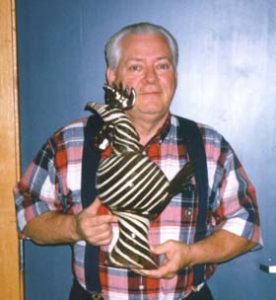“Thank goodness for that knee injury,” must whirl through Albert Hodge’s mind as his hands pull creations from the spinning clay. News from a doctor in the spring of 1989, mandating an early retirement, changed Hodge’s life for good. Out of misfortune, Hodge was able to find the artist lurking inside and experience a fulfillment of grandest kind.
Hodge’s journey began years before as a collector of vintage radios, among other things, and then pottery. He fell in love with the local 19th century pottery, much of it made in the area known locally as “Jugtown”, where Catawba and Lincoln counties meet. In 1987 Hodge began his new craft with some “accidental research”. Through his eyes he studied the shapes, styles, and even imperfections of his rough collection. One day, as he looked at the pieces time had cracked, he decided, he too, could mold art out of the earth.
Though he had never touched a wheel or sculpted anything out of clay, Hodge bought some supplies and equipment and began his craft. While there were mistakes and frustration along the way, Hodge had a clear vision, like any artist looking at raw materials, in what he could accomplish. He was a natural — no apprenticeship, no evening classes, no mentors. Looking at the hundreds of glazed urns, pitchers, vases and jugs, it is hard to imagine Hodge only doing this for a few years. Collectors come from miles, across states, to purchase the unique look of Hodge’s work. His popular signature style, the face jugs, are now known beyond his Vale home. When he unleashed his creativity, faces would form, those of animals, people, and make-believes. Fiendish faces, with devil horns, china plate teeth, with serpents wrapped around spouts no religious message here, just a face, as in a comic strip, that has become one of Hodge’s trademarks. His designs from his humble studio are scattered around the country in collectors’ homes and several museums, including the Smithsonian, the Henry Ford Museum and colonial streets of Williamsburg, VA
Among local collectors, Dr. Allen Huffman, of Hickory, prepared a recommendation letter and presented it to the Catawba County Council for the Arts on Albert Hodge’s behalf. The Huffmans have been collecting Hodge’s work since 1990. Among the artistic rewards Hodge reaps from being a potter, he has met people from all over the United States through showing and selling his art. Ten years ago he would never have imagined his hobby sitting on someone’s shelf, table or mantle.
Hodge makes about 20 pieces each week. Each piece takes about two weeks to mature. The pottery process is unpredictable. The life of a worked piece of clay balances delicately on beauty and waste. Designs can collapse before your eyes with too much pressure or one wrong move while shaping. One bubble of air can wreck an entire piece, as can a stick or rock in the clay. Pots can explode in the kiln if the temperature is not right. After being glazed with a handmade concoction, Hodge is a true folk potter, the shapes begin to take on the rich colors of the earth. Hodge mixes his glaze using rough ingredients like wood ashes or lime, forming an alkaline coating before firing his work in a 2300 degree kiln.
Like James Michener’s prominent writings, Albert Hodge’s passion surfaced late in life. In his late forties, he immersed himself in an art he never tried. His dreams materialized because he took a chance and believed he was capable. Yes, the talent helps, but without the guts, he would not be what he now believes was his destiny, a potter.*
Additional Links:


